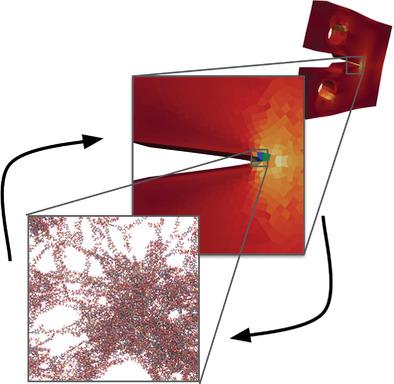当前位置:
X-MOL 学术
›
Adv. Theory Simul.
›
论文详情
Our official English website, www.x-mol.net, welcomes your
feedback! (Note: you will need to create a separate account there.)
Accelerating Heterogeneous Multiscale Simulations of Advanced Materials Properties with Graph‐Based Clustering
Advanced Theory and Simulations ( IF 2.9 ) Pub Date : 2020-12-10 , DOI: 10.1002/adts.202000234 Maxime Vassaux 1 , Krishnakumar Gopalakrishnan 1 , Robert C. Sinclair 1 , Robin. A. Richardson 1, 2 , Peter V. Coveney 1
Advanced Theory and Simulations ( IF 2.9 ) Pub Date : 2020-12-10 , DOI: 10.1002/adts.202000234 Maxime Vassaux 1 , Krishnakumar Gopalakrishnan 1 , Robert C. Sinclair 1 , Robin. A. Richardson 1, 2 , Peter V. Coveney 1
Affiliation

|
Heterogeneous multiscale methods (HMM) capable of simulating asynchronously multiple scales concurrently are now tractable with the advent of exascale supercomputers. However, naive implementations display a large number of redundancies and are very costly. The macroscale model typically requires computations of a large number of very similar microscale simulations. In hierarchical methods, this is barely an issue as phenomenological constitutive models are inexpensive. However, when microscale simulations require, for example, high‐dimensional molecular dynamics (MD) or finite element (FE) simulations, redundancy must be avoided. A clustering algorithm suited for HMM workflows is proposed that automatically sorts and eliminates redundant microscale simulations. The algorithm features a combination of splines to render a low‐dimension representation of the parameter configurations of microscale simulations and a graph network representation based on their similarity. The algorithm enables the clustering of similar parameter configurations into a single one in order to reduce to a minimum the number of microscale simulations required. An implementation of the algorithm in the context of an HMM application coupling FE and MD to predict the chemically specific mechanical behavior of polymer‐graphene nanocomposites. The algorithm furnishes a threefold reduction of the computational effort with limited loss of accuracy.
中文翻译:

基于图的聚类加速高级材料特性的异构多尺度模拟
随着亿级超级计算机的出现,能够同时模拟多个尺度的异构多尺度方法(HMM)如今变得易于处理。但是,幼稚的实现会显示大量的冗余并且非常昂贵。宏观模型通常需要计算大量非常相似的微观模拟。在分层方法中,这几乎不成问题,因为现象学本构模型很便宜。但是,当微观模拟需要例如高维分子动力学(MD)或有限元(FE)模拟时,必须避免冗余。提出了一种适用于HMM工作流的聚类算法,该算法可自动分类并消除冗余的微观仿真。该算法的特点是样条曲线的组合,以微尺度仿真的参数配置的低维表示和基于它们相似度的图形网络表示。该算法可以将相似的参数配置聚类到一个单一的配置中,以便将所需的微尺度仿真数量减少到最小。在结合FE和MD来预测聚合物-石墨烯纳米复合材料化学特异的机械行为的HMM应用程序中,该算法的实现。该算法将计算工作量减少了三倍,而损失的准确性有限。该算法可以将相似的参数配置聚类到一个单一的配置中,以便将所需的微尺度仿真数量减少到最小。在结合FE和MD来预测聚合物-石墨烯纳米复合材料化学特异的机械行为的HMM应用程序中,该算法的实现。该算法将计算工作量减少了三倍,而损失的准确性有限。该算法可以将相似的参数配置聚类到一个单一的配置中,以便将所需的微尺度仿真数量减少到最小。该算法在HMM应用程序中结合FE和MD来预测聚合物-石墨烯纳米复合材料的化学比机械性能的实现。该算法将计算工作量减少了三倍,而损失的准确性有限。
更新日期:2021-02-04
中文翻译:

基于图的聚类加速高级材料特性的异构多尺度模拟
随着亿级超级计算机的出现,能够同时模拟多个尺度的异构多尺度方法(HMM)如今变得易于处理。但是,幼稚的实现会显示大量的冗余并且非常昂贵。宏观模型通常需要计算大量非常相似的微观模拟。在分层方法中,这几乎不成问题,因为现象学本构模型很便宜。但是,当微观模拟需要例如高维分子动力学(MD)或有限元(FE)模拟时,必须避免冗余。提出了一种适用于HMM工作流的聚类算法,该算法可自动分类并消除冗余的微观仿真。该算法的特点是样条曲线的组合,以微尺度仿真的参数配置的低维表示和基于它们相似度的图形网络表示。该算法可以将相似的参数配置聚类到一个单一的配置中,以便将所需的微尺度仿真数量减少到最小。在结合FE和MD来预测聚合物-石墨烯纳米复合材料化学特异的机械行为的HMM应用程序中,该算法的实现。该算法将计算工作量减少了三倍,而损失的准确性有限。该算法可以将相似的参数配置聚类到一个单一的配置中,以便将所需的微尺度仿真数量减少到最小。在结合FE和MD来预测聚合物-石墨烯纳米复合材料化学特异的机械行为的HMM应用程序中,该算法的实现。该算法将计算工作量减少了三倍,而损失的准确性有限。该算法可以将相似的参数配置聚类到一个单一的配置中,以便将所需的微尺度仿真数量减少到最小。该算法在HMM应用程序中结合FE和MD来预测聚合物-石墨烯纳米复合材料的化学比机械性能的实现。该算法将计算工作量减少了三倍,而损失的准确性有限。











































 京公网安备 11010802027423号
京公网安备 11010802027423号